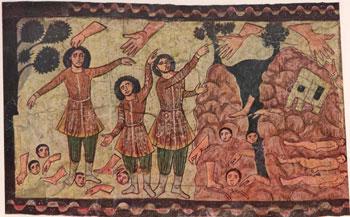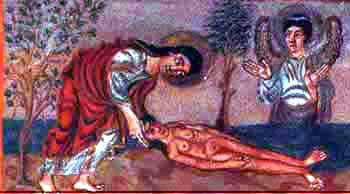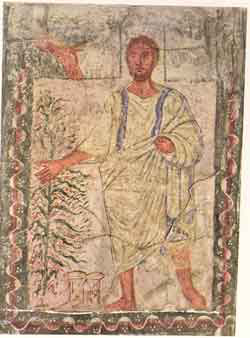Introduction
The frescoes covering the walls of the synagogue of Dura Europos are not only depictions of stories from the Bible, but they express, in their very selection and order, the beliefs and hopes of the the Jewish community that worshiped there in the mid-third century CE. The paintings are arranged in three horizontal rows or registers; the upper most row has been badly damaged. The middle register focuses on the ancient places of worship - the desert Tabernacle and the Jerusalem Temple, as well as the Temple of Dagon, god of the Philistines.
Unlike the middle register of paintings in the synagogue, the lower register contains a variety of separate scenes whose unifying theme is elusive. The paintings that have survived include scenes from the life of Elijah and the Purim story - to the left of the ark, and the anointing of David, the saving of the infant Moses and episodes from the book of Ezekiel to the right.
Paintings to the left of the Torah niche

Elijah Purim
-------->
Paintings to the right of the Torah niche

David Moses Ezekiel
<--------
Some have suggested that miraculous survival is the central theme of the register; others have mentioned rebirth and resurrection. But in each case, the suggestions do not account for all the paintings. As a result, we propose that the underlying motif of this register is "unexpected reversal of fortune that leads to triumph", in which God's presence is sometimes overt and at other times implied. It is significant that this register is at the congregation's eye level, and therefore serves as a continuous subliminal message.
We have here two examples of children, destined for greatness, who are saved from imminent death (baby Moses and the son of the widow of Zarefat). We have examples of the defeat of the many idolaters by the few faithful (Elijah against the prophets of Baal and the fall of Jerusalem's apostates). We have the startling choice of David, Jesse's youngest son, over his older brothers and in place of Saul, as the new king of Israel; and we have Mordecai's triumphant parade led by the foiled Haman through the streets of Shushan. And finally, we have the Vision of the Valley of Dry Bones.
The Ezekiel Cycle
The register contains the longest continuous panel in the synagogue - the Ezekiel cycle, composed of two distinct units: on the left, the Dry Bones vision and on the far right, an enigmatic scene of slaughter.

Section A
Starting from the left, three identical figures gesture amid body parts and a tree-topped mountain, split in two by a dark area is littered with a destroyed building.

Sometimes in Dura's paintings a character appears repeatedly, in adjacent panels as the story unfolds. Here, the prophet Ezekiel appears three times, as Moses also appears three times in the Exodus scene in the uppermost register. The following passage (Ezekiel 37) helps us identify the action (the choreography of hand gestures invites comment) :
Scene 1

Having lifted Ezekiel whose arms float like a bird, God sets him down among the bones.
Scene 2

Here, the prophet's hands form a direct diagonal with God's hand, an axis mundi. God poses an enigma, the prophet "hears" with his left hand and points with his right to the object of the dialogue.
Scene 3

Next, God's hand issues the order, Ezekiel's left hand accepts the challenge, while his right goes into action. The split mountain reveals a black interior. From deep in the earth, the graves open noisily (ra'ash) and the rattling bones come together.

C. Kraeling, the author of the definitive publication on the Dura Europos synagogue, concludes that human participation is an essential part of the miracle of the divine act.
Section B
The enlivenment
The biblical account continues:
(ט) וַיֹּ֣אמֶר אֵלַ֔י הִנָּבֵ֖א אֶל־הָר֑וּחַ הִנָּבֵ֣א בֶן־אָ֠דָ֠ם וְאָמַרְתָּ֨ אֶל־הָר֜וּחַ {ס} כֹּה־אָמַ֣ר ׀ אדני יהוה מֵאַרְבַּ֤ע רוּחוֹת֙ בֹּ֣אִי הָר֔וּחַ וּפְחִ֛י בַּהֲרוּגִ֥ים הָאֵ֖לֶּה וְיִֽחְיֽוּ׃ (י) וְהִנַּבֵּ֖אתִי כַּאֲשֶׁ֣ר צִוָּ֑נִי וַתָּבוֹא֩ בָהֶ֨ם הָר֜וּחַ וַיִּֽחְי֗וּ וַיַּֽעַמְדוּ֙ עַל־רַגְלֵיהֶ֔ם חַ֖יִל גָּד֥וֹל מְאֹד־מְאֹֽד׃
(9) Then [God] said to me, “Prophesy to the breath, prophesy, O mortal! Say to the breath: Thus said the Sovereign GOD: Come, O breath, from the four winds, and breathe into these slain, that they may live again.” (10) I prophesied as I was commanded. The breath entered them, and they came to life and stood up on their feet, a vast multitude.
As this bewildering prophecy becomes visual, an enigmatic scene unfolds before us.

On the lower left, the bones of three bodies have been knitted together. Ezekiel, having accepted God's orders (represented once again by a hand), points with his own left hand to the fulfillment. A winged angel leans over and touches the head of another inert body. Three graceful butterfly souls hover above those three bodies.
How then does God work in the prophecy and in the picture? Through agencies. In the text, God's agents are Ezekiel and the ruah (literally, wind, but also spirit, breath and direction). In the painting, God's will is fulfilled through additional agencies, reading diagonally from the upper left to the lower right: His hand, the butterfly souls and the winged angel. This proliferation of agencies derives from the attempt to visualize the mystery of the creation of life. The prophecy seems to be based in part on the account of Adam's creation in Genesis:
(ז) וַיִּ֩יצֶר֩ יְהֹוָ֨ה אֱלֹהִ֜ים אֶת־הָֽאָדָ֗ם עָפָר֙ מִן־הָ֣אֲדָמָ֔ה וַיִּפַּ֥ח בְּאַפָּ֖יו נִשְׁמַ֣ת חַיִּ֑ים וַֽיְהִ֥י הָֽאָדָ֖ם לְנֶ֥פֶשׁ חַיָּֽה׃
(7) God יהוה formed the Human from the soil’s humus, blowing into his nostrils the breath of life: the Human became a living being.
The Genesis description of God's action is entirely anthropomorphic. Some visual depictions of this scene are "literal",

God animates Adam with the breath of life,
Cathedral of Monreale, 11th century
while others seek a metaphor.

Jewish and Christian artists also drew on models from Hellenistic mythology, regarding the creation of Man by Prometheus and Psyche.

Naples, 4th century enlivening man,
Vatican, 3rd century
In some of these models, Prometheus animates a supine body by his touch; in others, a butterfly soul enters the standing figure. The butterfly emerging from the worm, symbolizes the transformation of the material into the spiritual.
These models flourished with variations. For example, a “butterfly”, poised to enter and animate the standing Adam, appears in the 11th century mosaics of the Cathedral of San Marco as the visualization of God’s breath of life.

God animates Adam, Spirit enlivening an inert body,
Cathedral of San Marco, Venice Dura Europos
11th century 244
In contrast, a large psyche-butterfly in Dura holds the head of one of the inert bodies in the Dry Bones panel, as God does in the Moutier Grandval bible and Prometheus does in the Naples sarcophagus. This mythological figure, a merging of the two models, acts as God’s agent, in the same way as the meimra (word of God) is an agent in the Aramaic Targumim of the same period – both are attempts to distance God from physical presence.
Peshat or Derash?
Having carefully illustrated the stages of Ezekiel's vision, the Durene painter now turns to its explanation:
(י) וְהִנַּבֵּ֖אתִי כַּאֲשֶׁ֣ר צִוָּ֑נִי וַתָּבוֹא֩ בָהֶ֨ם הָר֜וּחַ וַיִּֽחְי֗וּ וַיַּֽעַמְדוּ֙ עַל־רַגְלֵיהֶ֔ם חַ֖יִל גָּד֥וֹל מְאֹד־מְאֹֽד׃ (יא) וַיֹּ֘אמֶר֮ אֵלַי֒ בֶּן־אָדָ֕ם הָעֲצָמ֣וֹת הָאֵ֔לֶּה כׇּל־בֵּ֥ית יִשְׂרָאֵ֖ל הֵ֑מָּה הִנֵּ֣ה אֹמְרִ֗ים יָבְשׁ֧וּ עַצְמוֹתֵ֛ינוּ וְאָבְדָ֥ה תִקְוָתֵ֖נוּ נִגְזַ֥רְנוּ לָֽנוּ׃ (יב) לָכֵן֩ הִנָּבֵ֨א וְאָמַרְתָּ֜ אֲלֵיהֶ֗ם כֹּה־אָמַר֮ אֲדֹנָ֣י יֱהֹוִה֒ הִנֵּה֩ אֲנִ֨י פֹתֵ֜חַ אֶת־קִבְרֽוֹתֵיכֶ֗ם וְהַעֲלֵיתִ֥י אֶתְכֶ֛ם מִקִּבְרוֹתֵיכֶ֖ם עַמִּ֑י וְהֵבֵאתִ֥י אֶתְכֶ֖ם אֶל־אַדְמַ֥ת יִשְׂרָאֵֽל׃ (יג) וִידַעְתֶּ֖ם כִּֽי־אֲנִ֣י יְהֹוָ֑ה בְּפִתְחִ֣י אֶת־קִבְרֽוֹתֵיכֶ֗ם וּבְהַעֲלוֹתִ֥י אֶתְכֶ֛ם מִקִּבְרוֹתֵיכֶ֖ם עַמִּֽי׃ (יד) וְנָתַתִּ֨י רוּחִ֤י בָכֶם֙ וִחְיִיתֶ֔ם וְהִנַּחְתִּ֥י אֶתְכֶ֖ם עַל־אַדְמַתְכֶ֑ם וִידַעְתֶּ֞ם כִּֽי־אֲנִ֧י יְהֹוָ֛ה דִּבַּ֥רְתִּי וְעָשִׂ֖יתִי נְאֻם־יְהֹוָֽה׃ {פ}
(10) I prophesied as I was commanded. The breath entered them, and they came to life and stood up on their feet, a vast multitude. (11) And I was told, “O mortal, these bones are the whole House of Israel. They say, ‘Our bones are dried up, our hope is gone; we are doomed.’ (12) Prophesy, therefore, and say to them: Thus said the Sovereign GOD: I am going to open your graves and lift you out of the graves, O My people, and bring you to the land of Israel. (13) You shall know, O My people, that I am GOD, when I have opened your graves and lifted you out of your graves. (14) I will put My breath into you and you shall live again, and I will set you upon your own soil. Then you shall know that I, GOD, have spoken and have acted”—declares GOD.

The hand of God appears over Ezekiel, now wearing a Hellenistic himation and gesturing to his right. Features of panel A are repeated, including body parts and a tree-topped mountain. A group of ten himation-clad men stand before Ezekiel, their hands raised.
What is the meaning of the transformation from Persian to Hellenistic dress? From a split to a whole mountain? In both the text and the paintings, Ezekiel has gone from being a character in his own vision to being its interpreter; from being an ecstatic prophet to being a classical, rational prophet. He and the group of ten now wear Hellenistic garb, symbolic of sober perception.
But who are the ten? The text explains that the vision concerns “the whole house of Israel”. This statement is a derash on the vision: it explains that the Dry Bones are a metaphor for the people of Israel, hopelessly in exile. But contrary to expectation, God will miraculously return them to the land of Israel. However, the Dura painting, like much Jewish and Christian (e.g. Justin Martyr, First Apology, LII) literary commentary, reads Ezekiel's vision not as metaphoric but as literal (peshat): a vision of the future Resurrection. Thus, these ten are a minyan, the contemporary diaspora prayer community. And they will eventually be reborn and return to the land of Israel, symbolized by the mountain, now made whole.
Everything seems to fall into place except the "extraneous" figure in the center, the only Ezekiel not paired with the hand of God and unaccounted for in the text.

We suggest that this is Ezekiel our teacher, speaking to us, the congregation of Dura Europos. Earlier, Ezekiel had encouraged the despondent exile community of Israel settled on the River Chebar. He now speaks to us as our teacher, here at Dura on the Euphrates, a minority Jewish community in a precarious location on the border between the warring Roman and Sassanian empires. The hand of God, representing prophecy, is a thing of the past – today our rabbi Ezekiel encourages us, gesturing with his own hand, like a second Moses.


The enigmatic section C

The last panel in the lower register of the northern wall is a mess. Since it is undivided from the Vision of the Dry Bones, we are forced to seek a connection with Ezekiel. We suggest that the most appropriate text is found in chapter 9:
(א) וַיִּקְרָ֣א בְאׇזְנַ֗י ק֤וֹל גָּדוֹל֙ לֵאמֹ֔ר קָרְב֖וּ פְּקֻדּ֣וֹת הָעִ֑יר וְאִ֛ישׁ כְּלִ֥י מַשְׁחֵת֖וֹ בְּיָדֽוֹ׃ (ב) וְהִנֵּ֣ה שִׁשָּׁ֣ה אֲנָשִׁ֡ים בָּאִ֣ים ׀ מִדֶּרֶךְ־שַׁ֨עַר הָעֶלְי֜וֹן אֲשֶׁ֣ר ׀ מׇפְנֶ֣ה צָפ֗וֹנָה וְאִ֨ישׁ כְּלִ֤י מַפָּצוֹ֙ בְּיָד֔וֹ וְאִישׁ־אֶחָ֤ד בְּתוֹכָם֙ לָבֻ֣שׁ בַּדִּ֔ים וְקֶ֥סֶת הַסֹּפֵ֖ר בְּמׇתְנָ֑יו וַיָּבֹ֙אוּ֙ וַיַּ֣עַמְד֔וּ אֵ֖צֶל מִזְבַּ֥ח הַנְּחֹֽשֶׁת׃
(1) Then [God] called loudly in my hearing, saying, “Approach, you who are in charge of the city, each bearing his weapons of destruction!” (2) And six figures entered by way of the upper gate that faces north, each with his club in his hand; and among them was another one, clothed in linen, with a writing case at his waist. They came forward and stopped at the bronze altar.
In the continuation of this chapter, Ezekiel witnesses the slaughter of Jerusalem's apostates, who are dragged from the Temple and its environs. The painting has been both reworked and damaged, compounding its ambiguity. But it does seem clear that it serves as a counterpoint to the Vision of the Dry Bones, together representing the change from destruction to restoration. This motif requires us to reorder our reading of the panel as follows:
Destruction – Panel C (Ezek 9) –
The Dry Bones – Panel A (Ezek37:1 - 9)
The Restoration – Panel B1 and B3 (Ezekiel 37:10-14)
The Lesson – Panel B2
The lower register

In summary, in the Ezekiel images of the Dry Bones, the Durenes are expressing their certainty that destruction will turn into restoration/resurrection. This certainty expresses the unifying motif of the entire register: the unexpected reversal of fortune that brings salvation, in which God's presence is sometimes overt and sometimes covert. It is significant that this register is the most visually accessible to the congregation.
The Dry Bones live on
Having looked in detail at this earliest surviving treatment of Ezekiel's vision, we ask how these visions were sustained in later times.
The 11th century Catalonian Roda Bible contains a full page with four episodes from the Book of Ezekiel. One shows Dry Bones: the prophet, on the left, receives the divine command from a hand emerging from the arc of heaven; the scattered bones assembles as bodies rising from their graves and the four "winds" plus a central "spirit" animate them as they raise their hands in praise. Note that the winds' diagonal emanations are parallel to the emanations from the divine hand. This rendering is closest in iconography and chronology to Dura. But this, of course, is no restoration of Israel, nor is Ezekiel a central focus. Ezekiel's vision is merely a prooftext here for the Christian belief in the Resurrection that will accompany the Second Coming.

11th century

Late 19th century illustrator Gustave Dore's rendition evinces fascination with the macabre, typical of his times, as in the works of Edgar Allen Poe and Mary Shelly's Frankenstein. But Dore also takes a romantic devotional approach. The lower left portion of the image emphasizes the emergence of the dead from their graves, as in the New Testament story of Lazarus. Ezekiel, standing above within a halo of light, merges in an arc shape with one of the resurrected souls, a Christ-figure, thus providing a conscious connection between the Dry Bones vision and the central motif of resurrection in Christianity.
Finally, Benno Elkan's massive Knesset Menorah of 1956 contains over twenty images from the history of the Jewish people, sculpted in high relief. Probably under the influence of Dore, Elkan places Ezekiel at the center, with a billowing cape. But in clear contrast to Dore, the prophet does not stand apart from the people, but rather he crouches protectively over them, gathering them together. In this way, Elkan utilizes the Dry Bones as a symbol of the survival of the Jewish people, their renewal and ingathering after the Holocaust.

Benno Elkan, The Dry Bones, Knesset Menorah, 1956
These three images clarify the Dura rendition by giving us greater perspective on the endurance of an image through almost two millennia. In each age and generation the vision is reread in light of the changing present. Midrash is the dialogue of history with the biblical text.
For additional images on this subject see TALI Visual Midrash





